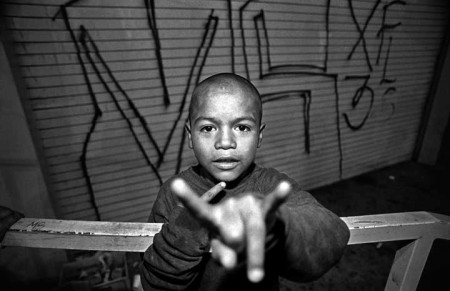Feeling threatened by Chicano and African American gangs, rebellious Salvadoran immigrant youth formed a gang of their own: Mara Salvatrucha.
The first MS group gathered at a corner grocery store in Koreatown. They called themselves the Mara Stoners: Mara because back home in El Salvador that slang expression described a close-knit band of friends, Stoner because marijuana was their drug of choice.

Mara Salvatrucha youths tag their territory with graffiti, Los Angeles, US. Copyright © Donna De Cesare.
Coming from El Salvador they listened mostly to heavy metal music. They were proud of their distinctive Salvadoran style -long flowing hair and tight torn jeans–but soon found it was out of sync with trends in the Chicano barrios of LA.
The “cholos” dominating LA’s Latino gang culture listened to “oldies” or “hip-hop.” Their clean or close-shaven heads and impeccably ironed oversized shirts and pants presented a stark contrast to the MS kids’ wild and unkempt look. Clashes over “pride” and “ethnicity” grew increasingly violent.
Gradually the MS members who landed in juvenile hall, or the county jail began accepting the “cholo style,” but to survive in prisons where Salvadorans were a small minority, they adopted a defiant new image and name–Mara Salvatrucha.
Inside the Southern California prison system the MS members found that Latinos who did not profess allegiance to the Mexican Mafia prison gang were the ultimate outsiders. In that first decade before Mara Salvatrucha finally joined “La EME” (as the prison gang is known) they survived the humiliations and constant violence inflicted, by cultivating and hyping an image of being the most violent and “craziest” of LA’s gangs.
The myth fed on certain more complicated realities. Most of the early Mara Salvatrucha members were Salvadoran immigrant kids. A few had had experience as child soldiers forcibly recruited by the Salvadoran government army or surviving by joining family members in the insurgent guerrilla army. Those who had not been “professional” soldiers often had horrifically traumatic memories of human rights abuses witnessed first hand. It was a brotherhood forged by shared emotional suffering.
The myth that the MS gang kids were more murderous than other kids in LA gangs was one that neither law enforcement nor the Salvatruchas -each for their own very different reasons–had interest in dispelling. Over time the results of this “misperception” have been as tragic as they have been unjust. The combination of hype, stigma and fear makes them easy scapegoats.